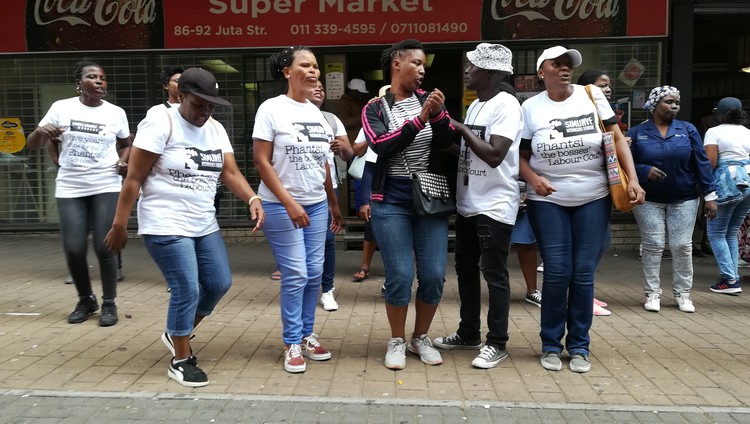
Former Ekurhuleni municipal workers demonstrated outside the Labour Court where their case was being heard. Photo: Zoë Postman
16 January 2020
The case of about 200 former Ekurhuleni municipal workers who claim that they should have been made permanent employees was heard at the Labour Court in Braamfontein, Johannesburg, on Tuesday.
The courtroom was filled to capacity with workers wearing T-shirts that read: “Five years fighting for our jobs”.
The workers were first employed by Ekurhuleni municipality under a job creation programme called Lungile Mtshali Development Plan Project in 2014. They were employed to clean the streets, drains, old age homes, municipal buildings, cemeteries and parks.
The programme ended in June 2015 and the workers’ contracts were terminated. Two months before the termination, the workers referred a case to the South African Local Government Bargaining Council (SALGBC), with the help of Lawyers for Human Rights (LHR), arguing that they should be made permanent employees of the municipality.
In December 2015, while the workers were waiting for their case to be heard at the bargaining council, they were approached by a company called Hlaniki Investment Holdings (Hlaniki) to perform the same jobs for the municipality.
This time, the contracts were signed by the workers, Hlaniki and a government agency called Gauteng Enterprise Propeller (GEP).
In September 2016, the workers referred another case to the bargaining council arguing that Hlaniki was acting as a Temporary Employment Service (TES) or a labour broker for the municipality and they should have been made permanent employees after three months.
Both the workers’ cases were heard at the bargaining council by commissioner Timothy Boyce in May 2018. Boyce found that the municipality should have made the workers permanent and made an arbitration award of R6,000 per worker.
But Boyce did not find that the municipality hired Hlaniki as a TES, based on the contracts.
LHR took Boyce’s ruling on review to the Labour Court, arguing that he had not looked beyond Hlaniki’s contract and assessed the actual implementation of the programme. LHR is now asking the Labour Court to review and set aside Boyce’s ruling.
“The arbitrator misidentified the true nature of the enquiry, and when determining whether a TES relationship existed between Hlaniki, the municipality and the [workers], confined himself to the written terms of the contract, and further confined himself to the description of the parties as appeared on the contract between Hlaniki, the [workers] and GEP, ” read LHR’s court papers.
LHR said that Hlaniki was hired by the municipality to recruit, provide and manage the workers.
Advocate Erin-Dianne Richards, representing the workers in court, argued that although Hlaniki had been hired by the municipality as a project manager and not a TES on paper, it was important to look at how the programme was actually implemented.
“The workers were being procured by Hlaniki and working for the municipality,” said Richards.
The municipality had a mandate to keep its areas clean and it was using employees on a rotational basis to fulfill those services without the responsibility of treating them as employees, she said.
But Advocate Mashudu Tshivhase, representing the municipality, accused LHR of “being on a fishing expedition”.
He said LHR could not expect the court to assume that Hlaniki was a TES when the tender award and contract clearly stated that it was hired for project management.
He also said that LHR’s case should not be directed at the municipality because it was Hlaniki’s client nor was it part of the contract between Hlaniki Investment Holdings, GEP and the workers.
Judgment was reserved.